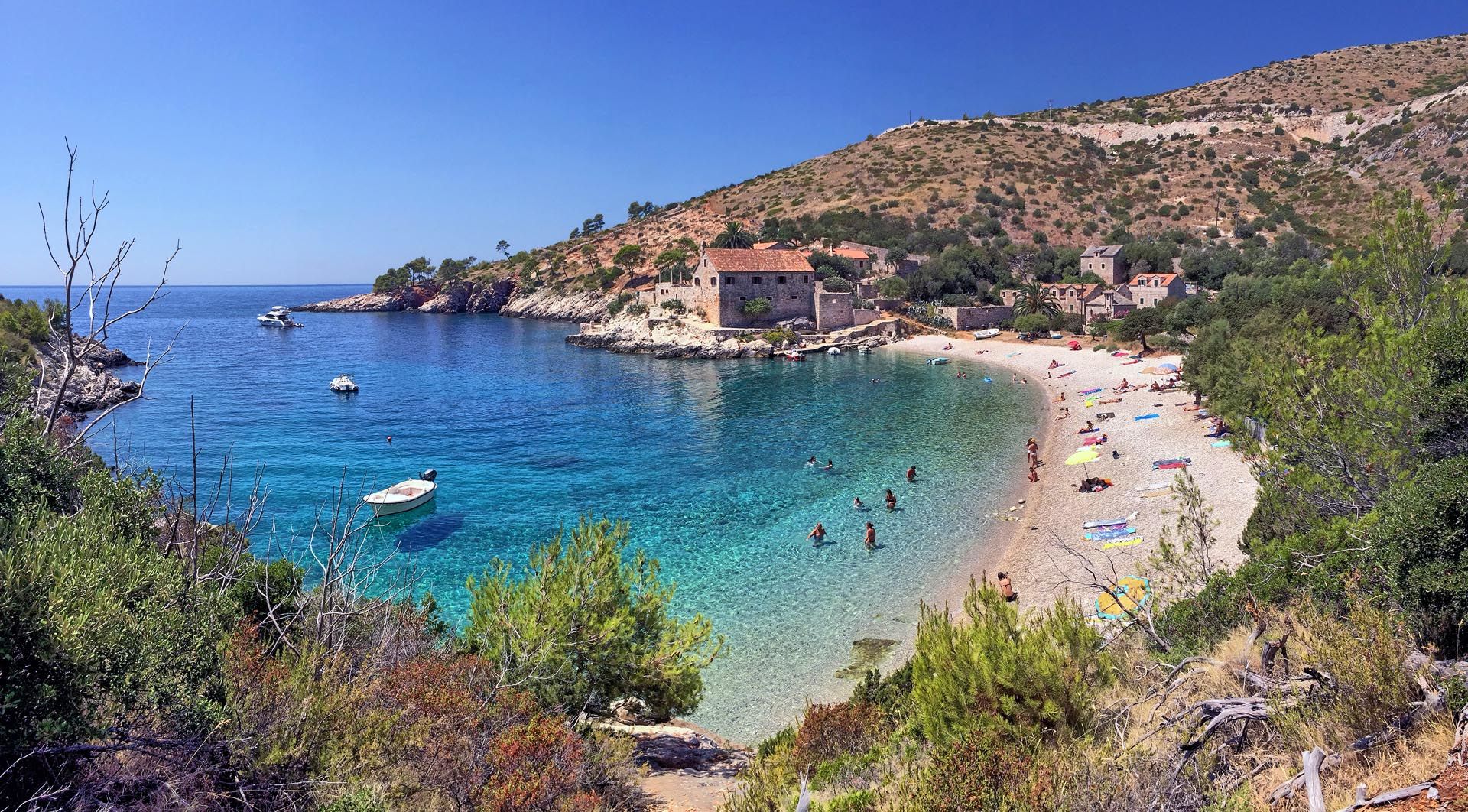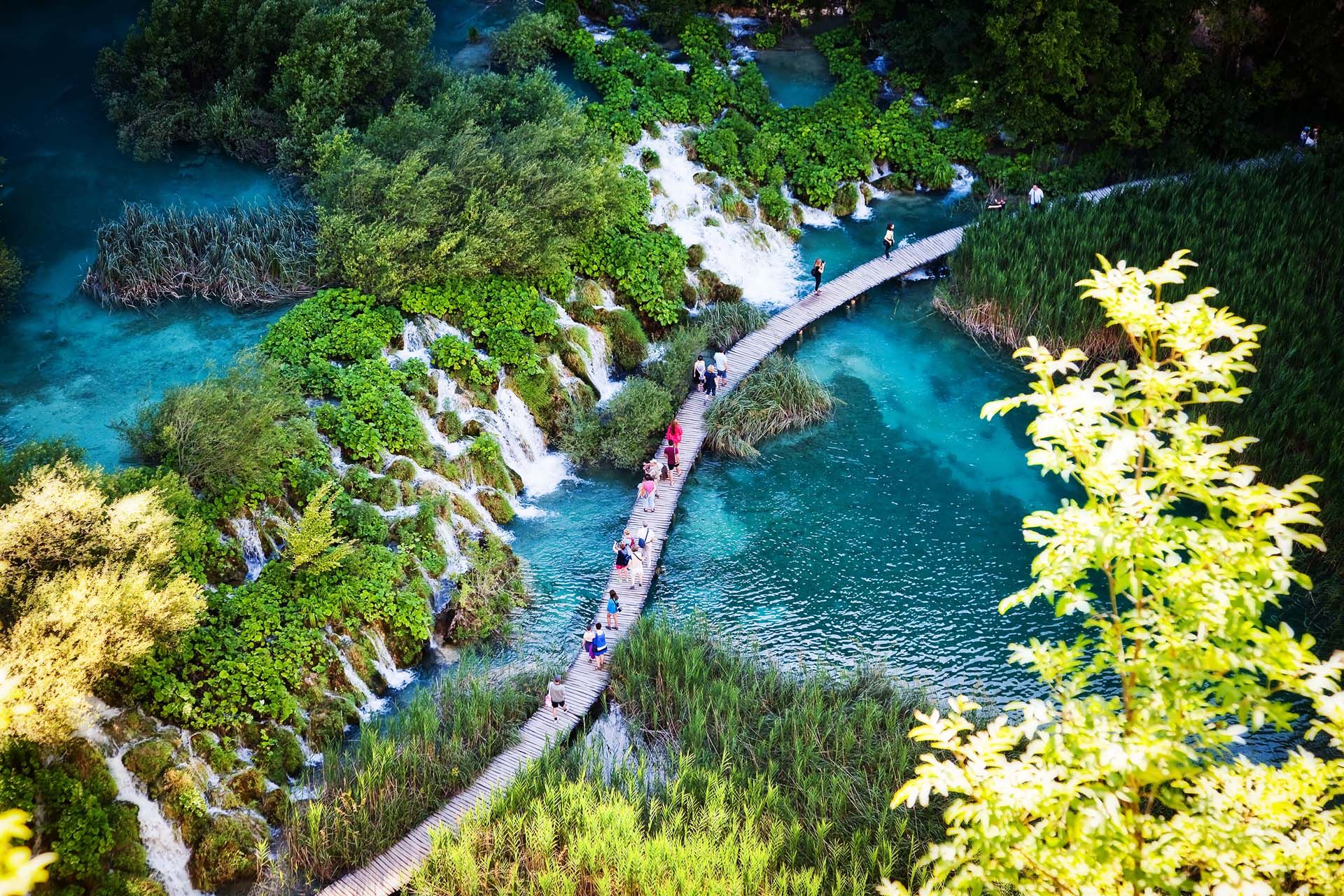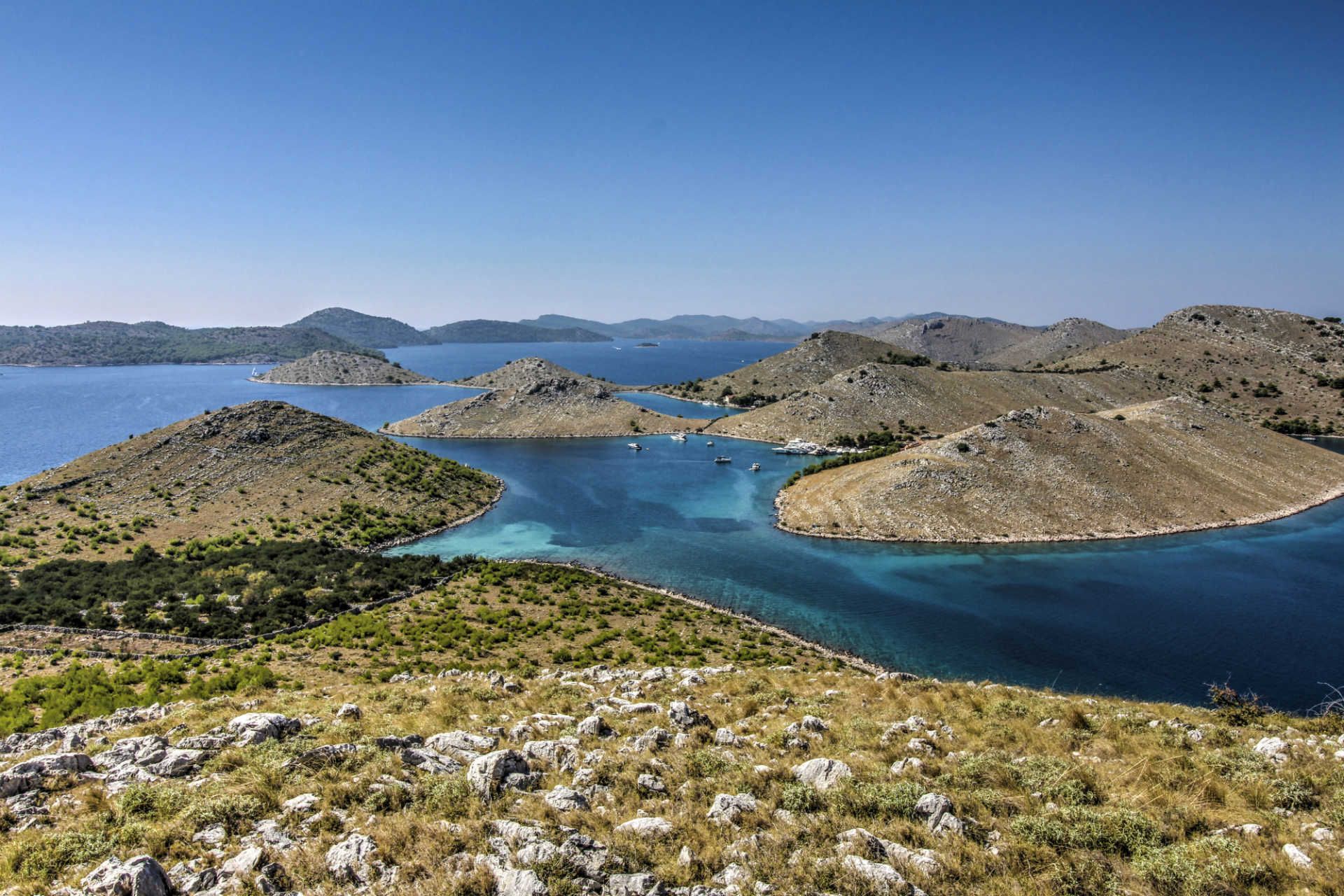Travel advice for Croatia
From travel safety to visa requirements, discover the best tips for visiting Croatia
Book your individual trip, stress-free with local travel experts
Plan your tailor-made trip with a local expert
Book securely with money-back guarantee
Travel stress-free with local assistance and 24/7 support
Figuring out when to go to Croatia goes hand-in-hand with planning an itinerary for your trip. Perhaps you’re hankering after some sun, sea and sand on the beaches of its extensive and glorious coastline and islands. You might intend to explore Croatia’s national parks and take advantage of the plethora of outdoor activities on offer, such as hiking, climbing, mountain biking, sea kayaking and sailing. If so, your trip will be weather dependent. Maybe you’re more focused on soaking up the country’s rich history and culture, in which case you won’t be put off by chillier temperatures or a bit of rain. If you’re enticed by Croatia’s burgeoning festival scene, this takes off in the summer months.
Chances are you’ll be looking at a combination of these things during your trip. So, for a taster of everything, the best time of year to visit Croatia is early or late summer. You’ll sidestep the hottest months of the season and it’ll be less busy all round.
Inland it’s a climate of contrasts, with sweltering temperatures in mid-summer, and freezing winters. The coast, however, experiences a Mediterranean climate – that is to say, hot in summer, mild in winter. So, if you’re planning to visit Croatia it’s worth taking a closer look at the country’s weather patterns.
Spring is sprightly by mid-March. It’s warm and dry, which makes it the best time to visit Croatia for cycling, hiking and sightseeing. Also, locals are likely to be particularly welcoming at this time of year – before the tourism season takes off again.
Easter is an important marker on the festival calendar, with religious processions in full swing on the islands of Hvar, Korčula and in many other parts of Croatia. In April, Zagreb hosts the Music Biennale festival (every odd-numbered year), showcasing contemporary classical music by top international artists.
Easter aside, April is also the best month to travel to Croatia for a shoulder season flight at bargain prices, and enjoy a city break.

Hopping over to the island of Hvar © Shutterstock
The early summer months are perfect for sunbathing: balmy temperatures lie between 23-27°C on the Adriatic coast, yet beaches are devoid of the crowds that appear as soon as school’s out. And by mid- to late May it can be warm enough in southern Dalmatia to swim in the sea. You’ll also have more stamina for sightseeing – before temperatures soar – and fewer people makes travelling between sights easier. For a smorgasbord of activities, this is perhaps the best time to visit Croatia.
This is peak season on the Adriatic, drawing foreign travellers, as well as Croats to its sunny sands. And if you like to combine beach action with a buzzing café culture this is the best time to go to Croatia. However, with soaring mid-summer temperatures on the coast (and inland), you may want to limit the amount of sightseeing you pack in.
Island hopping off the coast of Croatia is a big draw. In peak season you’d do well to arrive at ports early to get at the front of the queue for ferries. Also, bear in mind that accommodation soon fills up at the height of summer along the coast and islands, and facilities can be overstretched.
As most head for the coast, cities in the hotter interior of the country are pretty dormant this time of year, with little happening in the way of cultural or social activities. However, the relative quiet is ideal for a trip to take in the magnificent scenery at Croatia’s inland national parks, such as Plitvice Lakes, Risnjak and Northern Velebit.

Waterfalls at Plitvice Lakes © Shutterstock
Croatian culture heads for the coast in summer. Almost every Adriatic town organizes a cultural programme, usually featuring outdoor concerts of pop, classical music or folk. And Croatia has quite a reputation for hosting some of the best and diverse music festivals in Europe, which are in full swing by July. Read our summer festivals section for a round up of events, or check out our annual calendar for a full list.
September is the best month to visit Croatia for weather warm enough for idling on the beaches and swimming in the sea, and for island hopping – without the summer crowds. But the end of the month marks the end of the season and many islands close their bars and restaurants for the winter.

Kornati Islands © Shutterstock
It’s naturally much quieter throughout the country during the autumn months. This is, perhaps, the best time to travel to Croatia to enjoy inland Istria and national park areas, like the Plitvice Lakes and the River Krka. You’ll get to see foliage in full colourful glory and visitor numbers are low.
Come October the temperature of the Adriatic Sea is still warm enough to enjoy watersports, but coastal towns can be very quiet indeed, and many hotels and tourist attractions may well shut up shop for the winter. The cooler temperatures are better suited for pursuing outdoor activities, such as trekking and mountain biking. But don’t forget to pack wet weather gear and a snug extra layer, as it’s a rainier time of year and temperatures noticeably dip.
Given the innocuous winters on the Adriatic coast, this can be a good time for urban sightseeing in historic centres such as Zadar, Split and Dubrovnik. And budget travellers may find this the best time to visit Croatia for huge savings on hotel prices – over 50 percent on the Adriatic. cheaper than in peak season. Winters inland are a different kettle of fish entirely: snow is common and transport in highland areas is frequently disrupted as a result – though it can also be a picturesque backdrop to sightseeing.
Christmas in Croatia used to be a quiet affair as far as tourism goes, but the wonderful Christmas market in Zagreb has been enticing ever more visitors to the capital over the festive period. It’s a magical scene of cosy candlelight, little wooden huts selling gifts, alongside traditional cuisine and mulled wine, and outdoor concerts.
Dubrovnik comes to life in the first week of February with the Feast of St Blaise festival. Processions and pageantry, concerts and theatrical performances, honour the city’s patron saint.

Winter festival in Dubrovnik © Shutterstock
Croatia offers an increasingly crammed festival calendar, with rock and DJ events, annual beach parties, niche art gatherings and folksy fairs taking place up and down the Adriatic throughout the summer. The bulk of the ‘serious’ cultural festivals take place in Zagreb in spring and autumn. However, Dubrovnik, Split and Rijeka offer a lot in the way of heavyweight drama and music, and almost every region of the country offers a film festival of one sort or another. In addition, the Croatian year is peppered with religious holidays, featuring church processions and celebratory feasting.
So, if you’re wondering when is the best time to visit Croatia for one of its many festivals, here is a selection to help you decide, followed by a full calendar of events.
Please note that the current coronavirus situation means some events may be postponed or cancelled. Check individual events before booking your trip.
This is a selection of the best annual cultural events, including film, theatre, classical music and folk festivals, taking place in Croatia.
Croatia has muscled its way into the European party calendar in a major way. From late June to early September there’s a packed schedule of events, and big-name DJs perform every weekend at the dance clubs along the Adriatic coast.
Please note that the current coronavirus situation means some events may be postponed or cancelled. Do check individual events before booking your trip.

View over Split © Shutterstock
Please note that the current coronavirus situation means some events may be postponed or cancelled. Check individual events before booking your trip.
Snow Queen Trophy: World Cup downhill skiing on Mount Sljeme, with a big-screen broadcast on the main square. First and second weekends in Jan; Zagreb.
Feast of St Blaise: Processions and pageantry in honour of Dubrovnik’s patron saint. Feb 3; Dubrovnik.
Carnival: (Karneval; fašnik; pust). Processions, fancy dress and festivities in Rijeka, Velika Gorica and Samobor: Shrove Tuesday or weekend preceding.
Zagrebdox: A feast of documentary films from around the globe, with a packed week of screenings. Late Feb/early March; Zagreb.
Easter: Religious processions on the islands of Hvar, Korčula and in many other parts of Croatia. April or late March.
Music Biennale: Ten days of contemporary classical music featuring new work by major international composers. Every odd-numbered year; Zagreb.
Days of Croatian Film: Major review of Croatian films made during the previous twelve months, including features, shorts and documentaries. If you are on the lookout for new talent, this is the place to find it. Zagreb.
Feast of St Domnius: Church processions, craft fairs and feasting. May 7; Split.
Subversive Film Festival: A wide range of films and lectures on contemporary political topics, followed by the usual after-party drinking. Zagreb.
Roč Accordion Festival: Accordion bands from Croatia and beyond. Second weekend in May; Roč.
Festival of One-Minute Films: Exactly what it says in the title, with plenty of eccentric, experimental work. Late May; Požega.
Jewish Film Festival: A week of feature films, documentaries and post-screening concerts addressing wider issues of race and tolerance. Co-founded by Holocaust survivor and Oscar-winning producer Branko Lustig. Late May; Zagreb.
Festival of the European Short Story: Engaging and accessible lit-fest attracting major international participants (and big-screen English-language translations). A two-centre festival based in Zagreb and at least one Adriatic city. Late May/early June.
Cest is d’Best: Live bands and street entertainment on stages throughout the city centre. Early June; Zagreb.
Mediterranean Film Festival: New shorts and features from the Mediterranean region, screened in the open-air cinema behind Split’s Bačvice beach, with an accompanying after-show DJ programme. Early Jun; Split
Strossmartre: Summer-long sequence of gigs, puppet shows and open-air art in Zagreb’s Gornji grad. June to early Sept; Zagreb.
Animafest: Among the animation world’s most important and longest-running festivals, screening a week’s worth of commercial, arty and edgy films. Early June; Zagreb.
Contemporary Dance Week: Croatia’s premier dance event, with a strong contemporary edge. June; Zagreb.
Dan-D (“D-Day”): A long weekend devoted to contemporary design, with local creatives displaying their wares and DJ events in the evening. Mid-June; Zagreb.
Summer Nights: Classical music and drama in a variety of indoor and outdoor venues. Mid-June to late July; Rijeka.
InMusic: Three-day rock-and-pop fest on the shores of Lake Jarun, featuring major international bands and DJs. Attracting a daily average of 30,000 people, it’s big enough to feel like a major event but small enough to preserve a laidback vibe. Late June; Zagreb.
International Children’s Festival: Puppet shows, street entertainers and musicals, with a young audience in mind. Late June/early July; Šibenik.
Hideout. Festival of cutting-edge DJ music takes over Zrće beach for a long weekend. Late June; Novalja, Pag island.
Fantastic Film Festival: Week-long event devoted to fantasy, horror and sci-fi genres, with open-air screenings and DJ events. Late June/early July; Zagreb.
Dan-D ("D-Day"): A long weekend devoted to contemporary design, with local creatives displaying their wares and DJ events in the evening. Early July; Zagreb.
Kastav Summer of Culture (Kastafsko kulturno leto): Concerts in the streets and squares of Kastav, near Rijeka. July/Aug.
St Donat’s Musical Evenings: Classical soloists and ensembles performing in an early medieval church. Early July to early Aug; Zadar.
Đakovo Embroidery: Folklore groups from all over Croatia celebrate traditional costumes, music and dance. Early July; Đakovo.
Omiš Klapa Festival: Traditional choirs (klape) from all over the country, with prizes for the best performances. Omiš.
Dubrovnik Summer Festival: Prestigious classical music and theatre event that makes full use of Dubrovnik’s historic buildings and atmospheric open spaces. Early July to late Aug; Dubrovnik.
Electric Elephant: Five-day fest for connoisseurs of quality dance music old and new, on the dedicated seaside festival site first established by the Garden Festival. Mid-July; Tisno.
Ultra Europe Festival: Mega-popular DJ festival with leading names entertaining the masses in the Poljud Stadium. Mid-July; Split.
Courtyards: The semi-hidden courtyard spaces of Zagreb’s Upper Town are opened up to the public in a week-long festival of live music, wine and food. July; Zagreb.
Vanka Regule (“Outside the rules”): Sports- and activity-based festival with an imaginative range of everybody-can-join-in competitions, followed by outdoor gigs. Late July; Sutivan, Brač.
Stop Making Sense: The cream of cutting-edge London club culture descends on Dalmatia for another long weekend of round-the-clock partying. Mid-July; Tisno.
International Folklore Festival: Highly enjoyable display of ethnic music and dance from all over Croatia, plus a range of international guests. Mid- to late July; Zagreb.
Seasplash: Reggae fest in the Punta Christo fortress, just north of Pula. Late July.
Osor Music Evenings: International chamber music. Late July to late Aug; Osor, Cres.
Pula Film Festival: The country’s annual crop of feature films, screened in the Roman amphitheatre. Pula.
Rab Fair: Huge medieval pageant featuring parades, archery contests, fine victuals and hearty drinking. July 25, 26 & 27; Rab.
SuncéBeat: The Dalmatian offshoot of well-known UK DJ event the Southport Weekender, held at the Garden site at Tisno. Late July; Tisno.
Motovun Film Festival: High-art film festival that also functions as a five-day open-air party. Late July/early Aug; Motovun.
Split Summer: Opera, orchestral music and a host of other high-cultural delights, with many performances taking place in Split’s ancient piazzas and squares. Mid-July to mid-Aug; Split.
Supertoon Festival: Hugely enjoyable animation fest with outdoor screenings of kids’ films, music videos and arty stuff. Late July/early Aug; Šibenik.
Soundwave: Another long weekend of DJ-orchestrated bliss at the Tisno festival site; early Aug
Saljske užance: Seafood feasts, donkey races, island madness. First weekend in Aug; Sali, Dugi otok.
Alka: A sort of medieval joust held in celebration of the 1715 victory over the Ottomans. Early Aug; Sinj.
Neretva Boat Marathon: Teams in traditional rowing boats race through the Neretva delta towards the sea. Second Sat in Aug; Metković.
Days of Diocletian: Locals dress up as ancient Romans for a night of city-centre swords-and-sandals partying, symbolically welcoming third-century Emperor Diocletian back into town. Mid-Aug; Split.
Tilting at the Ring: Competition in which horsemen attempt to spear a ring on the end of a lance. Third weekend in Aug; Barban, Istria.
Špancirfest: One of the few festivals to light up inland Croatia during the month of Aug, Špancirfest takes over the centre of Varaždin with a week of outdoor variety performances alongside pop, rock and folk concerts. Late Aug; Varaždin.
Vukovar Film Festival: New features from southeastern European countries, screened at various outdoor venues around town. Late Aug; Vukovar.
Dimensions: Eclectic, experimental dance music festival at Fort Punta Christo near Pula. Late Aug; Pula.
Outlook: A spectacular treat for fans of jungle/dub/dubstep and beyond, with sound systems and live music stages in and around the Punta Christo naval fort. Early Sept; Pula.
PIF International Festival of Puppet Theatre: Puppet productions from all over Europe. Mid-Sept; Zagreb.
Korkyra Baroque Festival: Ten-day festival of early music, with many of the performances taking place in historic churches. Early to mid-Sept; Korčula Town.
Hartera: Weekend rock-fest in an adapted old factory complex. Sept; Rijeka.
Buzet Saturday: Gastronomic and musical fiesta dedicated to the opening of the truffle-hunting season. Second weekend in Sept; Buzet.
Festival of World Theatre: Seriously worthwhile drama festival attracting the big European names. Mid- to late Sept; Zagreb.
Split Film Festival: Shorts, documentaries and art-house films. Mid- to late Sept; Split.
Varaždin Baroque Evenings: One of Europe’s most prestigious early music events, with performances in Varaždin cathedral and other city churches. Mid- to late Sept.
International Festival of Experimental Film and Video: Moving pictures from the cutting edge. Late Sept; Zagreb.
BIT (Blind in Theatre): International festival for visually impaired theatre groups. Extraordinary and unique. Odd-numbered years only. Early Oct; Zagreb.
Zagreb Film Festival: Outstanding documentaries and art movies from around the world. Generates a genuine festival atmosphere: free access to the late-night DJ parties is well worth the price of your cinema ticket. Oct or Nov; Zagreb.
St Martin’s Day: Festivities in all wine-producing regions of the country, with the chance to taste and buy the season’s new produce. Nov 11 or nearest weekend.
Human Rights Film Festival: Politically engaged documentaries from around the globe, plus the inevitable after-parties. Early to mid-Dec; Zagreb and Rijeka.
Advent in Zagreb: Food stalls, rakija bars, kooky gift markets, outdoor music stages and gallons of mulled wine; venues throughout the city centre. Dec; Zagreb.
Header image: © Shutterstock
From travel safety to visa requirements, discover the best tips for visiting Croatia
written by
Rough Guides Editors
updated 25.05.2021